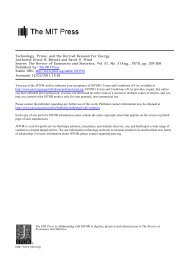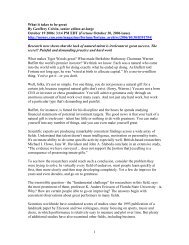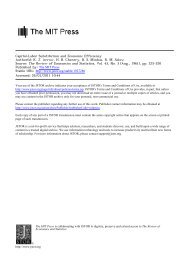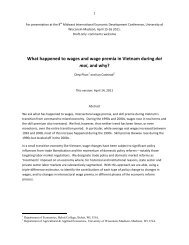Status of Wisconsin Agriculture 2010 - Agricultural & Applied ...
Status of Wisconsin Agriculture 2010 - Agricultural & Applied ...
Status of Wisconsin Agriculture 2010 - Agricultural & Applied ...
You also want an ePaper? Increase the reach of your titles
YUMPU automatically turns print PDFs into web optimized ePapers that Google loves.
mated at 189.2 billion pounds, down<br />
0.4 percent from 2008.<br />
Most <strong>of</strong> that drop in milk production<br />
happened out west, where dairy producers<br />
have experienced more financial<br />
stress because they received<br />
lower farm milk prices and paid<br />
higher prices for feed. California, the<br />
top dairy state produced around 39.5<br />
billion pounds <strong>of</strong> milk in 2009, about<br />
4 percent less and its lowest production<br />
since 2006. In Idaho, the<br />
nation’s third largest milk-producing<br />
state, production could drop 1.7 percent<br />
to 12.1 billion pounds. In contrast,<br />
<strong>Wisconsin</strong> continues to produce<br />
more milk. For the year, it is estimated<br />
that the state’s milk cow numbers<br />
will average 1.257 million head,<br />
up 0.4 percent from 2008. Milk production<br />
per cow in <strong>Wisconsin</strong> is estimated<br />
at 20,016 pounds, up 2.4<br />
percent. This will put <strong>Wisconsin</strong>’s<br />
total milk production at 25.2 billion<br />
pounds, an increase <strong>of</strong> 2.9 percent<br />
over 2008 and surpassing the previous<br />
record high <strong>of</strong> 25 billion pounds<br />
set back in 1988.<br />
The combination <strong>of</strong> s<strong>of</strong>t domestic<br />
milk sales, the loss <strong>of</strong> dairy exports<br />
and continued increases in milk production<br />
kept dairy product stocks<br />
more than ample to meet current<br />
demands. November 30 stocks <strong>of</strong><br />
butter were 18.5 percent higher than<br />
a year earlier, while American cheese<br />
stocks were up 10.6 percent and total<br />
cheese stocks were up 17.4 percent.<br />
Nonfat dry milk prices were near or<br />
below the CCC support price <strong>of</strong><br />
$0.80 per pound for the first seven<br />
months <strong>of</strong> 2009. CCC purchased surplus<br />
nonfat dry milk weekly until<br />
mid-August, when prices began to<br />
strengthen. Government stocks <strong>of</strong><br />
nonfat dry milk peaked at 247.1 million<br />
pounds on July 31 but fell to<br />
200.9 million pounds on October 31.<br />
The recent slowdown in milk production<br />
is reflected in reduced production<br />
<strong>of</strong> nonfat dry milk, which<br />
was down 6.4 percent January<br />
through September compared to a<br />
year ago. Non-government stocks <strong>of</strong><br />
nonfat dry milk stood at 121.7 million<br />
pounds on September 30, 14.2<br />
percent below a year ago, thanks to<br />
lower production and some improvement<br />
in domestic sales and exports.<br />
Reported production <strong>of</strong> dry whey<br />
through September was 3.1 percent<br />
lower. This drop in production along<br />
with improved domestic sales<br />
reduced dry whey stocks 25.4 percent<br />
below a year ago.<br />
Although stocks <strong>of</strong> dairy products<br />
were ample to excessive, dairy product<br />
prices strengthened significantly<br />
in October and November due to<br />
improvement in domestic and foreign<br />
sales and falling milk production.<br />
CME 40-pound cheddar blocks<br />
had averaged less than $1.15 per<br />
pound in May and June, but<br />
improved to $1.72 in early December<br />
before fallling back to $1.45 by<br />
year’s end. CME butter prices averaged<br />
$1.20 per pound in August but<br />
were up to $1.52 in November and<br />
back down to $1.33 by year’s end.<br />
Western nonfat dry milk prices were<br />
under $0.85 per pound January<br />
through July, but averaged $1.34 in<br />
December. Western dry whey sold<br />
for as little as $0.15 per pound in<br />
January and February but averaged<br />
$0.3950 in December.<br />
These higher dairy product prices<br />
greatly improved farm milk prices<br />
$/Lb.<br />
1.60<br />
1.40<br />
1.20<br />
1.00<br />
0.80<br />
0.60<br />
0.40<br />
0.20<br />
0<br />
y ,<br />
Dairy Product Prices, 2009<br />
CME 40 lb. Cheddar blocks<br />
CME butter<br />
West nonfat dry milk<br />
West dry whey<br />
Stocks <strong>of</strong> Dairy Products on<br />
November 30: 2009 vs. 2008<br />
Million % Change<br />
Product Pounds from 2008<br />
Butter 142.2 +18.5%<br />
American cheese 582.7 +10.6%<br />
Total cheese 961.4 +17.4%<br />
Nonfat dry milk<br />
(Manufacturers’ 90.1 -38.3%<br />
stocks)<br />
Dry whey 45.6 -27.6%<br />
Source: USDA, NASS. Note: Nonfat dry<br />
milk and dry whey stocks are as <strong>of</strong> October<br />
31. Nonfat dry milk stocks do not include<br />
CCC inventory.<br />
late in 2009. The Class III price was<br />
up to $12.82 per hundredweight in<br />
October and $14.08 in November<br />
compared to $9.97 in June and July.<br />
The average December Class III<br />
price is estimated at $14.80. If so, the<br />
Class III price will average $11.35<br />
for the year—$6.09 below the 2008<br />
average <strong>of</strong> $17.44.<br />
The Class IV price hit its yearly low<br />
<strong>of</strong> $9.45 per hundredweight in February.<br />
It climbed to $11.86 in October<br />
and $13.25 in November and is<br />
estimated at $14.50 for December,<br />
for a 2009 average <strong>of</strong> $10.85, $3.80<br />
lower than 2008. The <strong>Wisconsin</strong> Allmilk<br />
price hit its low <strong>of</strong> $11.40 per<br />
hundredweight in June and July and<br />
Jan Feb Mar Apr May Jun Jul Aug Sept Oct Nov Dec<br />
STATUS OF WISCONSIN AGRICULTURE <strong>2010</strong>—CURRENT OUTLOOK: DAIRY 19







